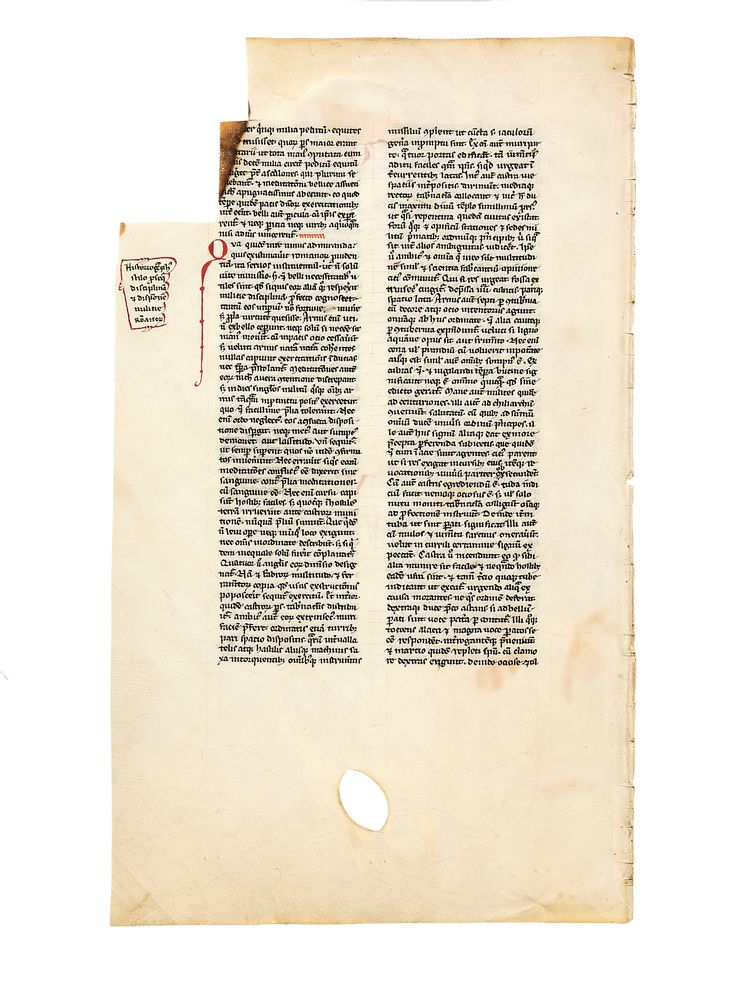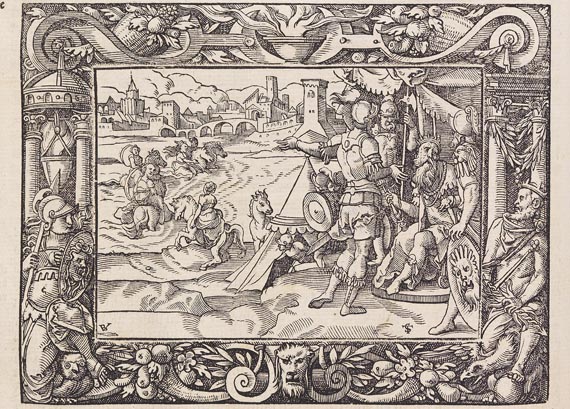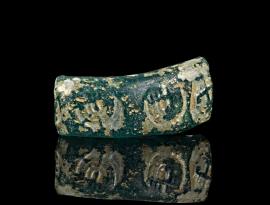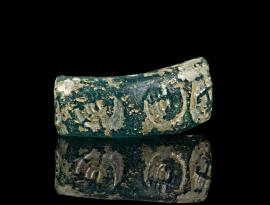TITUS FLAVIUS JOSEPHUS (37-100), The Jewish War , in the Latin translation attributed to Rufinus, decorated manuscript on vellum [France, late 12th century] Very elegantly laid out with exceptionally generous margins, a substantial portion of a fine copy of a major historical text. 12 leaves, each c.390×220mm, some leaves foliated in 20th-century pencil, ruled in plummet for 2 columns of 52 lines written above top line in black ink in a somewhat irregular early Gothic bookhand, ruled space c.230×140mm, rubrics and running headings in red, decorated with two- to five-line initials in red with ornamental embellishments, simple line-fillers in red, some leaves with a modern pencil inscription in French (e.g. ‘Extrait de l’évangile selon St Luc du XIII siècle’), one leaf with the gathering number ‘III’ and catchwords (the upper outer corner of some leaves fire-damaged, the burnt area usually cut off, usually with loss of a little text, the lower margins of a few leaves excised). Preserved loose in a custom-made grey buckram box. Provenance : (1) Marcel Mirgodin (d. c.1988), of Paris, couturier and bibliophile; two leaves were sold at Sotheby’s, 17 December 1991, lot 10; nine leaves were sold by Les Enluminures in December 1991 and one more in August 1992 to: (2) Schøyen Collection, MS 1561. Text : Titus Flavius Josephus, born Yosef ben Matityahu, was a first-century Romano-Jewish historian born in Jerusalem (then part of Roman Judea) to a father of priestly descent and a mother who claimed royal ancestry. The works of Josephus, The Jewish War chief among them, provide crucial information about the First Jewish-Roman War and revolt against Roman occupation, and also represent important literary source material for understanding the context of the Dead Sea Scrolls and late Temple Judaism. For many years, Josephus was largely known in Europe only in an imperfect Latin translation from the original Greek. Only in 1544 did a version of the standard Greek text become available in French, edited by the Dutch humanist Arnoldus Arlenius. The first English translation, by Thomas Lodge, appeared in 1602, with subsequent editions appearing throughout the 17th century. The 1544 Greek edition formed the basis of the 1732 English translation by William Whiston, which achieved enormous popularity in the English-speaking world. It was often the book— after the Bible — that Christians most frequently owned. The text here comprises Books III 1:1–7:22 (5 leaves) and III 7:29–8:35 (1 leaf), IV 11:5–V 1:5 (2 leaves), V 13:1–VI 1:1 (1 leaf), VI 1:5–2:7 (2 leaves), 5:3–7:3 (1 leaf) The text is very rare on the market: according to the Schoenberg Database, no copy has been offered at auction since 1956. Script : The simple decoration and wide margins (suitable for making notes) of the present leaves suggest that this was very much a text for study, rather than a bibliophile’s book for ‘show’. This impression is supported by the script: words are more heavily abbreviated than in earlier lots, the (crossed) tironian ‘et’ is used instead of the ampersand, double ‘ii’ is dotted but single ‘i’ is only dotted if adjacent minims might cause confusion, hyphens are used at line-ends, often formed as part of the final letter, tall ‘s’ is still used at the end, middle, and beginnings of words, but round ‘s’ occurs occasionally.
TITUS FLAVIUS JOSEPHUS (37-100), The Jewish War , in the Latin translation attributed to Rufinus, decorated manuscript on vellum [France, late 12th century] Very elegantly laid out with exceptionally generous margins, a substantial portion of a fine copy of a major historical text. 12 leaves, each c.390×220mm, some leaves foliated in 20th-century pencil, ruled in plummet for 2 columns of 52 lines written above top line in black ink in a somewhat irregular early Gothic bookhand, ruled space c.230×140mm, rubrics and running headings in red, decorated with two- to five-line initials in red with ornamental embellishments, simple line-fillers in red, some leaves with a modern pencil inscription in French (e.g. ‘Extrait de l’évangile selon St Luc du XIII siècle’), one leaf with the gathering number ‘III’ and catchwords (the upper outer corner of some leaves fire-damaged, the burnt area usually cut off, usually with loss of a little text, the lower margins of a few leaves excised). Preserved loose in a custom-made grey buckram box. Provenance : (1) Marcel Mirgodin (d. c.1988), of Paris, couturier and bibliophile; two leaves were sold at Sotheby’s, 17 December 1991, lot 10; nine leaves were sold by Les Enluminures in December 1991 and one more in August 1992 to: (2) Schøyen Collection, MS 1561. Text : Titus Flavius Josephus, born Yosef ben Matityahu, was a first-century Romano-Jewish historian born in Jerusalem (then part of Roman Judea) to a father of priestly descent and a mother who claimed royal ancestry. The works of Josephus, The Jewish War chief among them, provide crucial information about the First Jewish-Roman War and revolt against Roman occupation, and also represent important literary source material for understanding the context of the Dead Sea Scrolls and late Temple Judaism. For many years, Josephus was largely known in Europe only in an imperfect Latin translation from the original Greek. Only in 1544 did a version of the standard Greek text become available in French, edited by the Dutch humanist Arnoldus Arlenius. The first English translation, by Thomas Lodge, appeared in 1602, with subsequent editions appearing throughout the 17th century. The 1544 Greek edition formed the basis of the 1732 English translation by William Whiston, which achieved enormous popularity in the English-speaking world. It was often the book— after the Bible — that Christians most frequently owned. The text here comprises Books III 1:1–7:22 (5 leaves) and III 7:29–8:35 (1 leaf), IV 11:5–V 1:5 (2 leaves), V 13:1–VI 1:1 (1 leaf), VI 1:5–2:7 (2 leaves), 5:3–7:3 (1 leaf) The text is very rare on the market: according to the Schoenberg Database, no copy has been offered at auction since 1956. Script : The simple decoration and wide margins (suitable for making notes) of the present leaves suggest that this was very much a text for study, rather than a bibliophile’s book for ‘show’. This impression is supported by the script: words are more heavily abbreviated than in earlier lots, the (crossed) tironian ‘et’ is used instead of the ampersand, double ‘ii’ is dotted but single ‘i’ is only dotted if adjacent minims might cause confusion, hyphens are used at line-ends, often formed as part of the final letter, tall ‘s’ is still used at the end, middle, and beginnings of words, but round ‘s’ occurs occasionally.
.jpg)











Testen Sie LotSearch und seine Premium-Features 7 Tage - ohne Kosten!
Lassen Sie sich automatisch über neue Objekte in kommenden Auktionen benachrichtigen.
Suchauftrag anlegen